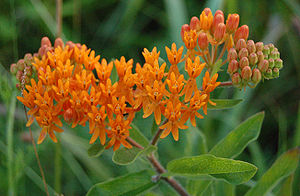Asclepias tuberosa
| Butterfly Weed | |
|---|---|
 | |
| Binomial: | Asclepias tuberosa |
| Family: | Apocynaceae |
| Type: | Perennial |
| Light requirements: | Full sun |
| Soil requirements: | Deep, rich, well-drained soil |
| USDA Hardiness Zone: | 4-9 |
| Weediness: | Self-seeds readily |
| Pollination: | Insects |
| Height and spread: | 0.6-2 m (1 -2 feet) tall |
| Toxicity and edibility: | Toxic if ingested, sap can cause skin irritation. |
Butterfly weed (Asclepias tuberosa, also called Canada root, Chigger flower, Chiggerflower, Fluxroot, Indian paintbrush, Indian posy, Orange milkweed, Orange Swallow-wort, Pleurisy root, Silky Swallow-wort, Tuber root, Yellow milkweed, White-root, Windroot) is a species of milkweed native to eastern North America, but also grown in gardens throughout the world for the showy flowers and the butterflies that are attracted to it.
The common name comes from the butterflies that are attracted to the plant by its color and its copious production of nectar. Butterfly weed is also the larval food plant of the Queen butterfly.
Description
[edit | edit source]It is a perennial plant growing to 0.6–2 m (1 –2 feet) tall, with cymes of orange, yellow, or nearly red flowers which are regular, perfect, 5-parted, top of flower (“crown”) with erectly held “hoods”. Pollen is in waxy masses. Flowers are produced from early summer to early fall. The leaves are spirally arranged, lanceolate, 5–12 cm long and 2–3 cm broad, hairy, dark green above and lighter beneath. The roots are thick taproots, to 30 cm long.

The seeds, borne in elongate pods, are also an attraction due to the large, silky pappus which are blown in the wind when ripe.
The plant looks similar to the Lanceolate milkweed (Asclepias lanceolata), however the Butterfly weed is uniquely identified by the larger number of flowers and hairy stems. It is most commonly found in fields with dry soil.
Growing conditions
[edit | edit source]In gardens, butterfly weed does best with a deep, rich, well-drained soil in full sun. In the wild it is often found in dry, sand or gravel soil, but has also been reported on stream margins.
Varieties
[edit | edit source]
- Asclepias tuberosa interior, Central United States.
- Asclepias tuberosa rolfsii (Rolfs Milkweed), Southeast United States.
- Asclepias tuberosa tuberosa, Eastern United States.
- ‘Gay Butterflies’ - is a commercial seed mix with varied flower colors.
- 'Hello Yellow' - has yellow flowers.
Uses
[edit | edit source]As a border perennial or meadow plant, primarily grown to attract butterflies to the garden. Can also be grown for cut flowers. The plant is often used in children's gardens for the seeds (for making "wishes" by blowing the seeds), as well as for the caterpillars and butterflies.
Maintenance
[edit | edit source]
Remove the forming seed pods to encourage reblooming, or leave them to develop the interesting seeds and for winter interest. Transplanting can be difficult due to the deep taptoot.
Propagation
[edit | edit source]Primarily by seed, but also by division or basal cuttings.
Harvesting
[edit | edit source]Does well as a cut flower, but leaves should be completely removed from the stems before putting in the vase.
Pests and diseases
[edit | edit source]See Asclepias for a list of pests and diseases. Caterpillars found on this plant are usually butterfly larvae, so if butterflies are desired, leave the caterpillars be.
References
[edit | edit source]- Peterson, Roger Tory (1968). A Field Guide to Wildflowers of Northeastern and North-central North America. Boston: Houghton Mifflin Company. ISBN 0-395-18325-1.
{{cite book}}: Unknown parameter|coauthors=ignored (|author=suggested) (help) - Britton, Nathaniel Lord (1913). An Illustrated Flora of the Northern United States and Canada, Volume 3 (second edition ed.). Dover Publications, inc. p. 25.
{{cite book}}:|edition=has extra text (help); Unknown parameter|coauthors=ignored (|author=suggested) (help) - Ann Fowler Rhoads and Timothy A. Block (2000). The Plants of Pennsylvania: An Illustrated Manual. Anna Anisko, illustrator. Morris Arboretum, University of Pennsylvania Press. p. 160.
- Christopher Brickell and Judith D. Zuk (1997). The American Horticultural Society A-Z Encyclopedia of Garden Plants. DK Publishing. p. 144.
- Staff of the L. H. Bailey Hortorium (1976). Hortus Third: A Concise Dictionary of Plants Cultivated in the United States and Canada. Cornell University Press. p. 117.
- Book:Horticulture/Finder/Types/Plants, Herbaceous
- Book:Horticulture/Finder/Seasons/Summer
- Book:Horticulture/Finder/Seasons/Fall
- Book:Horticulture/Finder/Lifetime/Perennial
- Book:Horticulture/Finder/Attractions/Butterflies
- Book:Horticulture/Finder/Uses/Fresh Cut Flowers
- Book:Horticulture/Finder/Native/North America